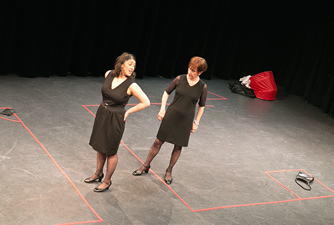The Brevard Philharmonic Orchestra‘s big draw in this fourth concert of their season was Clifford Leaman, Professor of saxophone at the University of South Carolina. Leaman’s performances of two works of the twentieth century, Henry Cowell’s Air and Scherzo for alto saxophone and small orchestra and Heitor Villa-Lobos’s Fantasia for soprano saxophone and chamber orchestra, were each preceded by more traditional concert fare, Johannes Brahms’s Variations on a Theme by Haydn and Maurice Ravel’s Le tombeau de Couperin. Conducted by Maestro Donald Portnoy, the concert sponsored by Addie Blake also served as a tribute to Emerson Head, conductor of this orchestra from 2005-2007.
Leaman is a recipient of the Master of Music and Doctor of Musical Arts degrees in performance from the University of Michigan. He has previously served on the faculties of Furman University, Eastern Michigan University and the University of Michigan. He has taught and performed internationally and recorded for Redwood Records, CRS, and the University of Arizona Recordings. He has also commissioned and given the world premiere performances of numerous works, including concertos by two Pulitzer Prize-winning composers.
Leaman is a musical artist of the first order whose reputation as a great interpreter of contemporary works is well justified. Composed in 1963 for sax and piano and later orchestrated, the Cowell Air began with a wavering string accompaniment that later served as a backdrop to the sax’s lyrical lines, rendered by Leaman with a beautiful and controlled vibrato. A contrasting section exacted a jump in the sax to the realm of its strident upper register where it played in tandem with prominent clarinets before a return to the opening music. The Scherzo is quizzically headed “The Gay Sad Gay Scherzo (The Gay minor, the Sad major)” to indicate its madcap explorations of these modes. The demands of this rollicking and accessible movement entailed blistering, fast scales and passagework on the sax in tandem with the orchestra.
Equally appealing was the Fantasia for Soprano Saxophone and Orchestra of 1948 by Brazilian-born Heitor Villa-Lobos. More like a mini-concerto in three movements than a freer-formed fantasy, the work’s mystique hinges on its exotic aura and rhythm liveliness. For this the orchestra was reduced to a smaller group of strings and horns which were kept in good balance with the soloist. Though labeled “Animé,” the first movement was not without its slower, lyrical moments and here the sax’s voice blended beautifully into the ensemble. Leaman has a gorgeous sound and a sure touch, no matter what the technical demands are of the score. The second movement “Lent” began with a viola solo, and the movement unfolded with the sax part wafting very independently of the orchestral accompaniment. The third movement “Très animé” followed briskly without pause to conclude the work.
The highlight of the orchestral works on the concert, hands down, was Ravel’s Le tombeau de Couperin. This gorgeous and sumptuously colored work consists of four of the original six movements for piano. It was composed between 1914 and 1917 during a period of depression following the death of the composer’s mother and the conclusion of WWI, a war which had a devastating effect on him. The work was orchestrated in 1919 and premiered in 1920. As a “tombeau,” it is a type of homage made famous by French Baroque composers; here Rameau intended it to be an homage to this period of Baroque music. The four movements — Prelude, Forlane, Minuet, and Rigaudon — function like a Baroque dance suite and elicited the best orchestral playing of the afternoon. Particularly outstanding were the wind solos, especially those of principal oboist Emily Scheider in the Forlane and Minuet.
The afternoon’s disappointment was, unfortunately, the concert opener. Brahms’s much-loved Variations on a Theme by Haydn, Op. 56a simply did not get its due in this lack luster read-through. The musicians were barely seated before the baton was raised to start the music. The impression — that no one was really ready or even concentrating — was borne out in variations which were, sadly, not terribly distinguished from one another other than their changing orchestrations. The tepid applause was a signal that the audience, too, felt Brahms had been under served.











